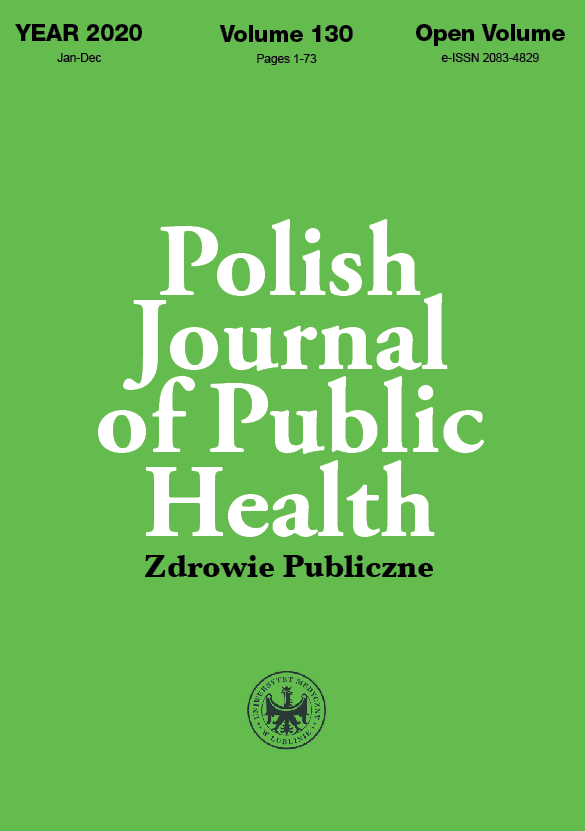Diagnostic methods used in children with malocclusion
DOI:
https://doi.org/10.2478/pjph-2020-0009Keywords:
imaging, diagnostics, malocclusion, children, orthodontics.Abstract
Introduction. With advances in technology, there has been a need for more precise imaging methods which have become an integral part of the orthodontic treatment plan.
Aim. The aim of this study is to present diagnostic methods that are currently used in children with malocclusion.
Material and methods. The materials analysed in this review are articles from PubMed and Google Scholar. To identify relevant publications, the search was carried out using the key word combination: imaging, diagnostics, malocclusion, children, orthodontics. The number of 16 research papers in which these keywords appeared were qualified for this review.
Results. According to the mentioned publications, pantomographic images are the most frequently recommended method for detecting dental anomalies. Cephalometry was used to observe changes in the facial axis and to measure the length of the jaw.
CBCT is being used more and more often, mainly to identify possible prognostic factors in the case of canine retention/eruption in the maxilla. The method of magnetic resonance imaging was also compared with cephalometric images.
Conclusions. 1. The pantomogram is a useful and frequently used method in the detection of craniofacial anomalies. 2. Cephalometry allows the effects of the treatment to be monitored. 3. CBCT is a significant diagnostic tool to assess the growth of craniofacial structures. 4. MRI diagnostics limits the patient’s exposure to harmful ionizing radiation. 5. There is a need to educate medical staff and conduct further research on the methods of diagnostic imaging in children
References
1. Shah N, Bansal N, Logani A. Recent advances in imaging technologies in dentistry. World J Radiol. 2014;6(10):794-807.
2. Stupar I, Yetkiner E, Wiedemeier D, et al. Influence of Lateral Cephalometric Radiographs on orthodontic treatment planning of Class II patients. Open Dent J. 2018;12:296-302.
3. Mouyen F, Benz C, Sonnabend E, Lodter JP. Presentation and physical evaluation of RadioVisioGraphy. Oral Surg Oral Med Oral Pathol. 1989;68(2):238-42.
4. Choi J-W. Assessment of panoramic radiography as a national oral examination tool: review of the literature. Imaging Sci Dent. 2011;41(1):1-6.
5. Quintero JC, Trosien A, Hatcher D, Kapila S. Craniofacial imaging in orthodontics: historical perspective, current status, and future developments. Angle Orthod. 1999;69(6):491-506.
6. Silling G, Rauch MA, Pentel L, et al. The significance of cephalometrics in treatment planning. Angle Orthod. 1979;49(4):259-62.
7. Devereux L, Moles D, Cunningham SJ, McKnight M. How important are lateral cephalometric radiographs in orthodontic treatment planning? Am J Orthod Dentofacial Orthop. 2011;139(2):e175-181.
8. Farman AG, Scarfe WC. Development of imaging selection criteria and procedures should precede cephalometric assessment with cone-beam computed tomography. Am J Orthod Dentofacial Orthop. 2006;130(2):257-65.
9. Katsumata A, Hirukawa A, Noujeim M, et al. Image artifact in dental cone-beam CT. Oral Surg Oral Med Oral Pathol Oral Radiol Endod. 2006;101(5):652-7.
10. Idiyatullin D, Corum C, Moeller S, et al. Dental MRI: Making the Invisible Visible. J Endod. 2011;37(6):745-52.
11. Pallikaraki G, Sifakakis I, Gizani S, et al. Developmental dental anomalies assessed by panoramic radiographs in a Greek orthodontic population sample. Eur Arch Paediatr Dent. 2020;21(2):223-8.
12. Pakbaznejad Esmaeili E, Ekholm M, Haukka J, Waltimo-Sirén J. Quality assessment of orthodontic radiography in children. Eur J Orthod. 2016;38(1):96-102.
13. Heil A, Gonzalez EL, Hilgenfeld T, et al. Lateral cephalometric analysis for treatment planning in orthodontics based on MRI compared with radiographs: A feasibility study in children and adolescents. PLOS ONE. 2017;12(3):e0174524.
14. Alqerban A, Storms A-S, Voet M, et al. Early prediction of maxillary canine impaction. Dentomaxillofac Radiol. 2016;45(3):20150232.
15. Alqerban A, Jacobs R, Fieuws S, Willems G. Radiographic predictors for maxillary canine impaction. Am J Orthod Dentofacial Orthop. 2015;147(3):345-54.
16. DiBiase AT, Lucchesi L, Qureshi U, Lee RT. Post-treatment cephalometric changes in adolescent patients with Class II malocclusion treated using two different functional appliance systems for an extended time period: a randomized clinical trial. Eur J Orthod. 2020;42(2):135-43.
17. Pereira J da S, Jacob HB, Locks A, et al. Evaluation of the rapid and slow maxillary expansion using cone-beam computed tomography: a randomized clinical trial. Dental Press J Orthod. 2017;22(2):61-8.
18. Raucci G, Pachêco-Pereira C, Grassia V, et al. Maxillary arch changes with transpalatal arch treatment followed by full fixed appliances. Angle Orthod. 2015;85(4):683-9.
19. Idris G, Hajeer MY, Al-Jundi A. Soft- and hard-tissue changes following treatment of Class II division 1 malocclusion with Activator versus Trainer: a randomized controlled trial. Eur J Orthod. 23 2019;41(1):21-8.
20. Naoumova J, Kjellberg H. The use of panoramic radiographs to decide when interceptive extraction is beneficial in children with palatally displaced canines based on a randomized clinical trial. Eur J Orthod. 2018;40(6):565-74.
21. Lineberger MB, Franchi L, Cevidanes LHS, et al. Three-dimensional digital cast analysis of the effects produced by a passive self-ligating system. Eur J Orthod. 2016;38(6):609-14.
22. Sambataro S, Fastuca R, Oppermann NJ, et al. Cephalometric changes in growing patients with increased vertical dimension treated with cervical headgear. J Orofac Orthop. 2017;78(4):312-20.
23. Cerruto C, Ugolini A, Di Vece L, et al Cephalometric and dental arch changes to Haas-type rapid maxillary expander anchored to deciduous vs permanent molars: a multicenter, randomized controlled trial. J Orofac Orthop. 2017;78(5):385-93.
24. Al-Dumaini AA, Halboub E, Alhammadi MS, et al. A novel approach for treatment of skeletal Class II malocclusion: Miniplates-based skeletal anchorage. Am J Orthod Dentofacial Orthop. 2018;153(2):239-47.
25. Pittayapat P, Bornstein MM, Imada TSN, et al. Accuracy of linear measurements using three imaging modalities: two lateral cephalograms and one 3D model from CBCT data. Eur J Orthod. 2015;37(2):202-8.
26. Durão AR, Alqerban A, Ferreira AP, Jacobs R. Influence of lateral cephalometric radiography in orthodontic diagnosis and treatment planning. Angle Orthod. 2015;85(2):206-10.
27. Isaacson K, Thom AR. Orthodontic radiography guidelines. Am J Orthod Dentofac Orthop. 2015;147(3):295-6.
28. Hans MG, Palomo JM, Valiathan M. History of imaging in orthodontics from Broadbent to cone-beam computed tomography. Am J Orthod Dentofac Orthop. 2015;148(6):914-21.
Downloads
Published
Issue
Section
License
Copyright (c) 2021 Polish Journal of Public Health

This work is licensed under a Creative Commons Attribution-NonCommercial-NoDerivatives 3.0 Unported License.


